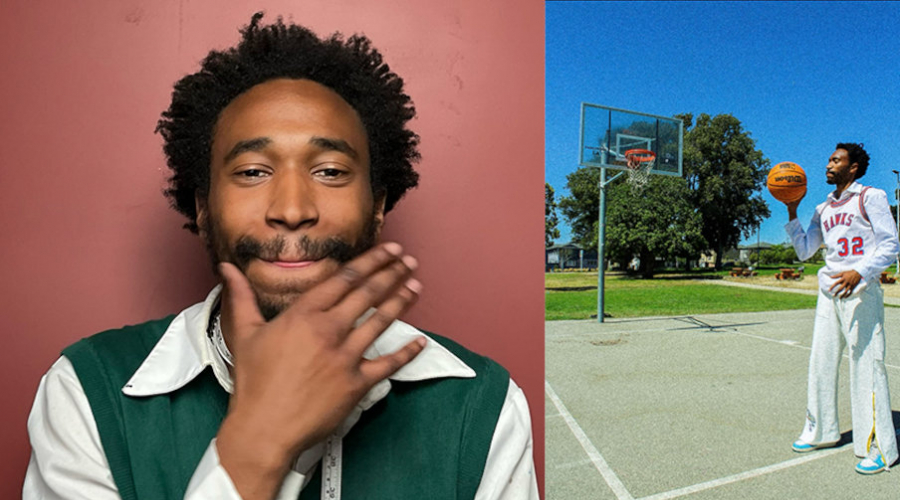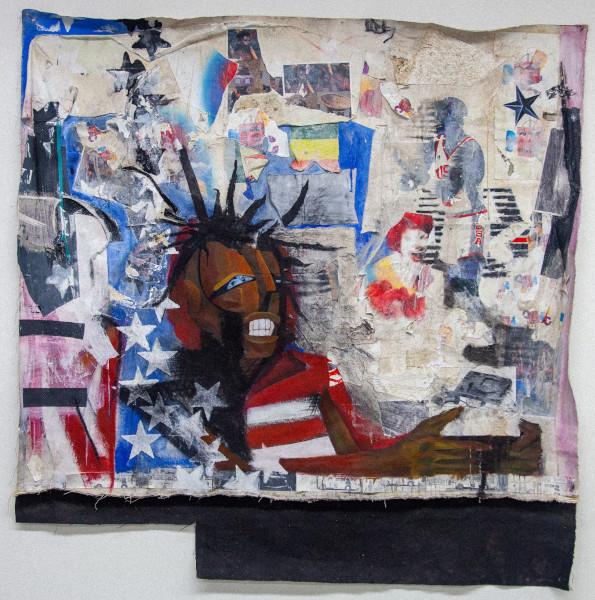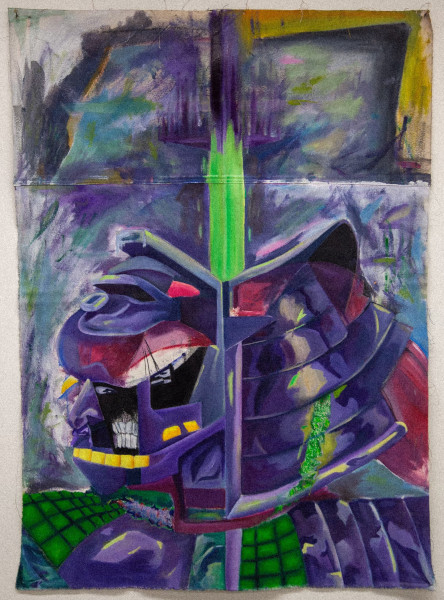
Cass Everage was at Cal Poly Pomona, considering majoring in graphic design but interested in art, when Jaime Scholnick, an artist and his Foundations of 3D instructor, saw some of the sculpture work he was making for the class and recommended he explore art and design school. “She introduced me to [Otis faculty member] Cole James, who told me about the Charles White scholarship and said I should apply for it,” Everage says. More than a year later, he is now a junior at Otis College majoring in Fine Arts with an emphasis in Painting, merging mediums like painting and quilt-making. He is confident and hopeful for the future he’s carving out for himself as an artist inspired by Kerry James Marshall (’78 BFA Fine Arts) and David Hammonds (’72 Fine Arts)—both former Charles White pupils and influential artists in their own right.
Charles White (1918-1979) was a renowned draftsman, painter, printmaker, graphic artist, and activist. He was the head of the Drawing Department at Otis when he died in 1979, after having mentored artists across generations—including Marshall, Judithe Hernández (’74 BFA Fine Arts), and Kent Twitchell (’77 MFA Fine Arts) among others—as well as racial and cultural identities. The Charles White Art and Design Scholarship honors White’s legacy with a four-year full-tuition undergraduate scholarship at Otis College of Art and Design. Everage was the inaugural recipient.
Everage recently spoke to us about his work and the exciting opportunities he’s been able to explore at Otis.
Did you know who Charles White was before you applied?
I didn't know about Charles White before, but I did know about his students and contemporaries like Kerry James Marshall, David Hammons, and Noah Purifoy, people like that. Learning about Charles White was, I think, a really nice tie-in with all those artists, but I didn’t know that he was also so prevalent in the culture and even T.V. and movies.

What type of work are you doing right now at Otis, and how is it aligning with what you want to do when you graduate?
I’ll start with my materials. I obviously paint, but I was never a trained painter. Most of what I do now is kind of in this guerilla-esque style where I’m mixing different mediums like charcoal and oil paint with paper and screen-print ink—something that you typically wouldn’t do, but I’ve found a lane for myself in exploring the relationships of mediums like that. I also take a great deal from the aesthetics of rap, particularly in how it behaves as a philosophy and a culture in juxtaposition/cooperation with, say, something like John Dewey Individualism. This is largely why I love the advent of accessible means of making and I use paint in the fashion in which I do. I am still developing my practice and seeing how these aesthetics grow in relation with what I learn and observe in the near and distant future. I am also doing a bunch of quasi-internships in downtown L.A. in what I can only refer to as the scene of underground fashion and culture that I am very blessed to be in proximity to. Shout out to the gang downtown.
I really like to make my own clothes and am into what I’m calling neo-African American quilt-making, where it’s like a reverberation of traditional African quilting but I’m using all means and technologies that I would use in my streetwear practice. It looks totally different, and I’m having a lot of fun with it. Those two things are kind of existing simultaneously right now. This is how my studio practice is shaping up and I can only hope to expand it upon graduation.
Do you think because you didn't have any prior art training before Otis you’re more willing to take risks?
Oh, for sure. It’s often really hard to separate oneself from predisposed value propositions of quality and rendering-capacity, like, say, an artist like Charles White—who is brilliant in exactly that way and more—but I’ve been really finding strength, power, and agency in the fact that my individual material experience is informing the work. I’m not yet indoctrinated to any particular means of making, and I hope to retain that attitude. But I will admit the training does help. And if you are going to kind of subvert that training, I think it takes a special type of person, because a lot of times that training is in place for a reason. But in my experience, I found [my lack of material experience] to be an advantage for sure.
How does receiving the Charles White Scholarship impact your ability to carve out your creative future?
I would say it helps a lot, mentally and physically. Not in the way of seeking validation, but rather in that I just did not know I could do what I’m doing right now, let alone where I want to take it. And getting the “Charles White stamp” or the “Otis stamp” was really good for my confidence and exploration. Not that the confidence is explicitly tied to a tangible reward, but it helps. Physically, it’s introduced me to a lot of people and enabled me to not have to stress everyday about tuition costs—a privilege that is just not a reality for a lot of people within my demographic. I just want to acknowledge that and say that I appreciate the opportunity.

How important is it for art and design institutions like Otis College to create opportunities like the Charles White Scholarship for BIPOC students?
I think it’s incredibly important because when I think about, from just a “Western art canon perspective,” when speaking to someone about Black artists, the first person, the only person, they are likely to think of is Basquiat—not all the names I listed before, like David Hammons, Kerry James Marshall, Arthur Jafa, or John Outterbridge, as big as they are. The conversation just kind of stays there. I think opportunities like this scholarship, that allow people such as myself to envision a path like this, are empowering and just good for art in general.
Is there anything else you want to express about yourself, your work, or the fact that you are the first Charles White Scholarship recipient?
As the first scholarship recipient there is a kind of pressure for me to show everyone what the heck this scholarship is going to be outside: “What if I get out of here and I just bust?” Then it’s going to look really bad, but it’s a great pressure to have. When I think about, say, Michael Jordan, when he was getting signed with Nike there was doubt. There were these questions. Because of that pressure, and because he was a specific type of individual, it actually propelled his greatness because he had to live up to the standard. Obviously, I’m still in school, it’s too soon to tell, but I’m confident in the work that I’m making. I hope that the scholarship holds some weight to supplement the work when I get out of here, if you know what I mean. But I recognize that I get to see what it means for me. To be honest with you, though, I just want to keep reading, making, and listening to Lil Yachty as much as I can.
All images courtesy of Cass Everage. From top: Call of the North Star (5 feet 9 inches by 5 feet six inches); Deacon (5.3 feet by 3.35 feet)


